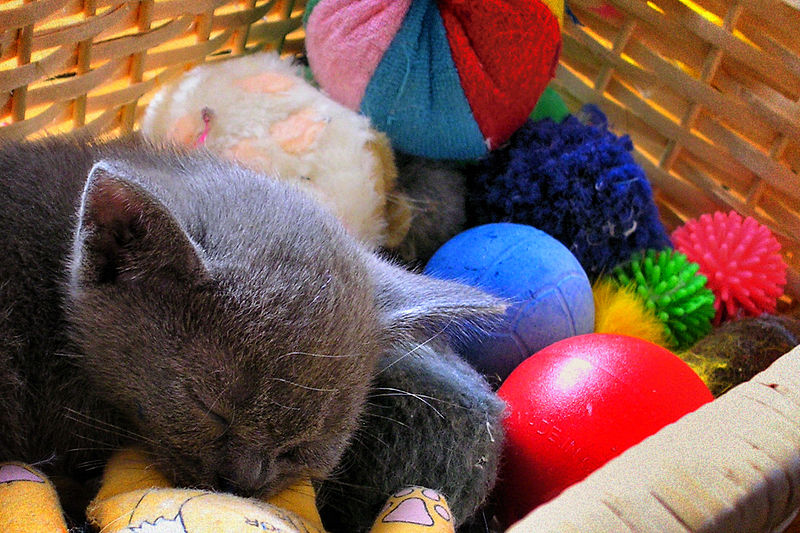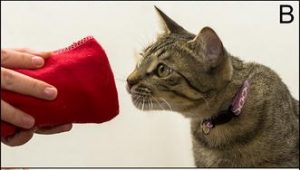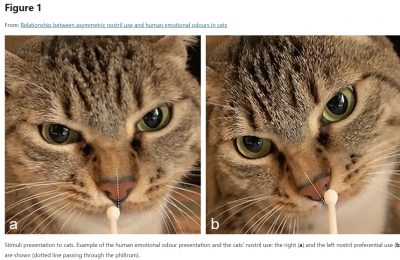Do you play with your cat? How about every day? Be honest. I know most of you reading this are pretty lazy about playing with your cats (I can be too). You might even blame it on your cat…”Oh…he doesn’t really like to play with toys,” “She liked to play when he was a kitten, but now that she’s older, she prefers to cuddle.” I’ve heard it all before and I know it’s a lie! Why? Because to cats, play should be practice for predation, and cats are natural-born killers who cannot resist the opportunity to pounce! This doesn’t mean that the play is always fun for the human, who may or may not be particularly skilled at eliciting those killer behaviors in their cats. But we’ll get to that. First, let’s look at a recent study examining how play might influence the behavior of cats.
“An Owner Survey of Toys, Activities and Behavior Problems in Indoor Cats” was recently published in the Journal of Veterinary Behavior. The study was a survey of 277 veterinary clients in Tennessee who were bringing their cats in for a veterinary visit (coming for anything besides a behavior problem rendered someone eligible to participate). The goal of the study was to examine just how much playtime owners give their cats, and how this might be correlated with behavior problems.
Owners were asked standard questions about their cats (such as if they were spayed/neutered, the cats’ sex and the like). The survey also asked owners if the cats eliminate outside of the litterbox, fight with other cats, and if they bite and scratch people. They were next asked how often and long they play with their cat, and what types of toys/activities they provide for their cats (e.g. balls, mice, stuffed toys, catnip, etc.). Finally, they asked participants if they talk to their veterinarian about any behavior problems their cat might be experiencing.
On the human side of things, all owners stated that they played with their cat at least once a month, with 64% claiming to play at least twice a day. Most owners played with their cat for 5-10 minutes at a time. The majority of people (78%) reported leaving toys out all the time for their cat.
On the cat side, we’ve got a lot of naughty kitties out there. Sixty-one percent of owners reported at least one undesirable behavior, with many cats displaying aggression toward people (36%), closely followed by urination outside the litterbox (24%) and aggression between cats in the home (21%). Of those owners with “problem children,” only half of them had mentioned the problem to their veterinarian.
Was playtime correlated with behavior problems? Maybe. The owners who played with their cats for longer periods of time reported fewer behavior problems (on average one behavior problem, compared to the 2.25 behavior problems reported by those who played with their cat for only one minute at a time). Behavior problems were strongly related to the sex of the cat, with male cats being more likely to have reported behavior issues, regardless of neuter status.
I do think we should interpret these results with some caution. First of all, we have a very small sample size of people (less than 10) who reported they only play with their cat for one minute at a time. These people may not be representative of a random sampling of people who don’t play much with their cat, and of course, we don’t know if the decreased play is the cause of the behavior problems, or the result (or because of something else altogether). We also don’t know if those who claimed to play with their cat for longer periods of time were being honest. Perhaps many of them only play for one minute as well, they just didn’t feel like admitting it!
We also don’t know if people who bring their cats to the vet regularly are different from pet owners who do not. More than half of all pet cats do not get a yearly exam, due in large part to the fact that many cats are afraid of their cat carrier (a subject for another blog post!). So it’s possible that the cats represented in this survey are also somehow different from your average pet cat, for better or worse.
On behavior problems: it seems like a lot of cats are having them (more than reported in a previous study). Is this because people are making less time for their cats? Are more cats bored and indoors? (For the record, I advocate keeping cats indoors only, but it needs to be a loving, fun and stimulating environment!) They also didn’t report whether age correlated with behavior problems, but I wonder if aggression toward humans is more prevalent in younger cats and kittens, with more of a playful/predatory bent, than the more fearful, defensive types of aggression problems seen in some cats.
Most people don’t mention behavior problems to their veterinarian, and while the authors suggest that veterinarians can be a resource for help, (no diss on vets, but…) I think it’s important to remember that most veterinarians do not get much (if any) training in cat behavior. In many veterinary programs, ONE multi-species behavior course is an elective, not a requirement (see here, here and here for examples of veterinary curricula). Many veterinarians admit they know little about behavior, while others may give outdated or just bad behavior advice!
That said, veterinarians are hopefully making progress on this end, and hopefully know of some resources for cat-owners that they can at least point them to (such as veterinary behaviorists, CAABS, the IAABC and Cats International) if they can’t answer a client’s behavior-related questions! Because behavior issues are a major reason that cats are surrendered to shelters, it is important to intervene and provide assistance early!
This study reveals some valuable information about pet owners and the type of activities they provide for their cats and I have plenty of thoughts about the findings! This study found owners reporting even less playtime with cats than data from a study in 1997, where owners reported 20-40 minutes of daily play with their cats. Sadly, the current figure is probably not enough to meet most cats’ needs.
Furthermore, people need to expand their selection of toys and activities. In the current study, only 39% of owners reported using an interactive (“fishing pole”) toy with their cats. This is a travesty! Only NINE percent had a cat tree, four percent trained their cats to do tricks, and less than one percent provided food puzzles as enrichment for their cats. I’d say those are four “magic bullet” things that all cats owners can do to immediately improve their cats’ lives, and sadly, not many people are doing any of them.
So for those of you who might be cringing about the kitty care you are providing right now, I’m going to give you a few quick tips to make playtime easier for you and your cat:
Think like prey – get interactive (that means a toy with a stick that you move, not a toy you just toss across the room) toys that resemble birds, bugs and mice. Move them like birds, bugs and mice! Quiver, skitter, hop, but whatever you do, don’t shove the toy in your cat’s face. No self-respecting mouse would do that. Also, don’t feel the need to wildly wave the toy around constantly. This might work for kittens, but older cats need more calculated play…bringing me to my next tip:
Take advantage of your cat’s stalk and rush hunting style. Stalk and rush means that the predator spends a lot of time carefully watching prey before making a very hasty and deadly attack. Cats really like the “pre-pounce” phase – where the toy is barely moving for many seconds. Watch their eyes – are their pupils dilated? Is their butt wiggling? Are their whiskers forward? If yes, you have feline focus!
This short burst style of hunting means that you don’t always need 20 minute play sessions with your cat. Several 5-10 minute sessions are likely just as effective! Just make sure your cat has a little time to calm down from the play before taking the toy away.
Use all of their senses! We are visual, so we tend to think that cats are too. But they want to use their senses of smell, sound and touch too! Try toys scented with catnip, or small amounts of mint, valerian or even cat food. Remember their sense of smell is much stronger than ours, so a little bit will go far. The scent may help them track toys as you move them around.
Move toys against a scratchy surface, like under a paper bag or rug, or hide the toy behind a table leg and gently tap the toy against the leg. The sound will immediately pique your cat’s interest!
Be sure to let the cat catch and touch the toy frequently. They have many sensitive nerve endings and whiskers in their face and paws to help them hunt. These are designed to help them capture prey. This why lazer pointer play can get frustrating; they can never catch the toy.
Rotate toys – a previous study suggested that cats don’t get bored of play – they get bored of the same old toy. So be sure to take some toys away, and put out different ones. Have multiple interactive toys for play sessions. Switch toys if your cat seems to lose interest and see if she is re-engaged!
I hope now you feel a little more inclined to pick up that dusty cat dancer that’s been sitting in the back of your closet and give your kitty a little exercise! You may even have fun and create a bonding moment with your cat…and if you’re lucky, you’ll prevent some behavior problems too!








